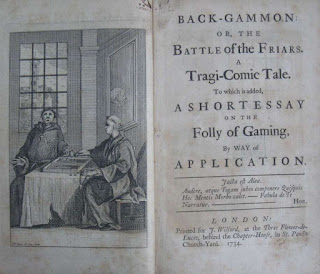In the Gibbs essay, I discussed the first edition of Mathews as follows:
Only two copies of the first edition survive. Mine bears an inscription in Gibbs's hand "Aldenham. 1901. Given me by Julian Marshall." Indeed the provenance is even better, both earlier and later. Julian Marshall bought a copy of Mathews's first, almost certainly mine, at the 1900 Sotheby's auction of books from the estate of Cavendish, whom I have anointed the successor to Hoyle. I purchased the book from the collection of Dr. Albert Ferguson, who wrote a couple of bridge books and put together an important collection of gaming books about which I shall write later. When I look at the Mathews, I see a line from Cavendish to Marshall to Gibbs to Ferguson and then to me.The title page and inscription by Gibbs are pictured below.
 |
| First edition (1804) Levy [1743] |
 |
| Inscription by Henry Hucks Gibbs |
Rather than naming the author, the first edition, printed in Bath by W. Meyler and Sons, purports to be written "by an amateur." I have not seen a copy of the second edition of 1806, but I believe the title page indicates that Thomas Matthews is the author; I can confirm that his name appears on the third edition of 1808. With three editions in four years, you should have the sense that the book was popular. Indeed Jessel's Bibliography of Works on Playing Cards and Gaming (1905) lists 19 Bath-printed editions through 1832 followed by an undated 20th edition. Jessel notes that after the thirteenth edition, the name is always spelled "Mathews" rather than "Matthews." Two more of the English editions are pictured below:
 |
| Sixth edition (1811) Levy [1023] |
 |
| Eleventh edition (1818) Levy [1130] |
The book was quickly published abroad. There is an 1812 Boston edition "from the second English edition" and one from New York in 1813 "from the fourth London edition" (although the book was printed in Bath rather than London). Boston bookseller Edward Cotton issued Mathews in two works in 1814. The Whist Players Manual: Containing Hoyle's Payne's, and Matthews' Directions, Maxims, and Instructions for the Game of Whist is a small 75 page book consisting of the whist books of all three authors. The same text and same setting of type appears as the first portion of Cotton's Hoyle's Games Improved. Cotton introduces Mathews work as follows:
Mr. Mathews (London) having published "Instructions to the Young Whist player" which have been very highly approved by good Players, it has been thought expedient to add them to this work, that the student may compare the with Hoyle's and Payne's maxims, and directions, and follow such as appear most reasonable and practical.
 |
| Cambridge, MA (1847) Levy [1456] |
Another American edition ("First American from the twentieth London edition") was published by the Cambridge Whist and Chess Club in 1847. Jessel notes an English provincial edition (Cheltenham: G. A. Williams, 1822) and an edition printed in English in India (Madras: J. R. Hogg, 1825).
 |
| Paris (1838) Levy [1403] |
.JPG) |
| Facing English and French text (1838) |
Unlike that of Hoyle, we are fortunate to know something of Mathew's life. Emanuel Green delivered three papers with biographies of prominent Bath citizens before the Bath Antiquarian Field Club in December, 1902, and January and February, 1903.
 |
| Green (1903) Levy [1457] |
The papers were collected in Thomas Linley, Richard Brinsley Sheridan, and Thomas Mathews, Their Connection with Bath (Bath: Herald Office, 1903). The title page, inscribed by Green is pictured at left.
Much of Green's paper discusses and defends Mathews who was involved in feuds and duels with the Sheridan and Linley families. Rather than dredge up old unpleasantness, I'll focus on Green's comments about Mathews and whist:
Besides his social qualifications he has left a much wider repute, more valued and remembered perhaps than all other adventures or duelling squabbles. Bath during this time was the centre or head quarters for the game of whist and in this game Mathews became the leading spirit and authority, being always referred to for many years in all the first circles at Bath on disputed points in the game. His name is well recalled by all players to-day from his having published a little book entitled--Advice to the young whist player...At the Club established in York Buildings in 1790, and in other card rooms it was always placed ready for reference. (page 77)
 Green reproduces a portrait of Mathews, shown at right. We don't have a portrait of Hoyle (see "Hoyle's Scoring Method and Whist Counters"), nor am I aware of any portrait of William Payne. I don't consider General Scott, who's portrait appears as a frontispiece in his 1814 Easy Rules for Whist (see "Eighteenth Century Whist Literature") as a significant contributor to the game. So it is delightful to have a likeness of at least one of the early important whist writers.
Green reproduces a portrait of Mathews, shown at right. We don't have a portrait of Hoyle (see "Hoyle's Scoring Method and Whist Counters"), nor am I aware of any portrait of William Payne. I don't consider General Scott, who's portrait appears as a frontispiece in his 1814 Easy Rules for Whist (see "Eighteenth Century Whist Literature") as a significant contributor to the game. So it is delightful to have a likeness of at least one of the early important whist writers. 
































